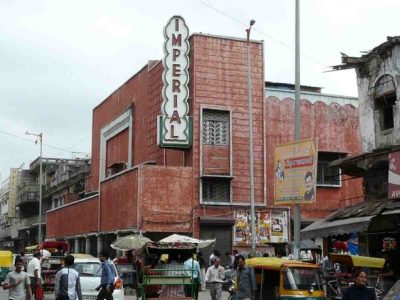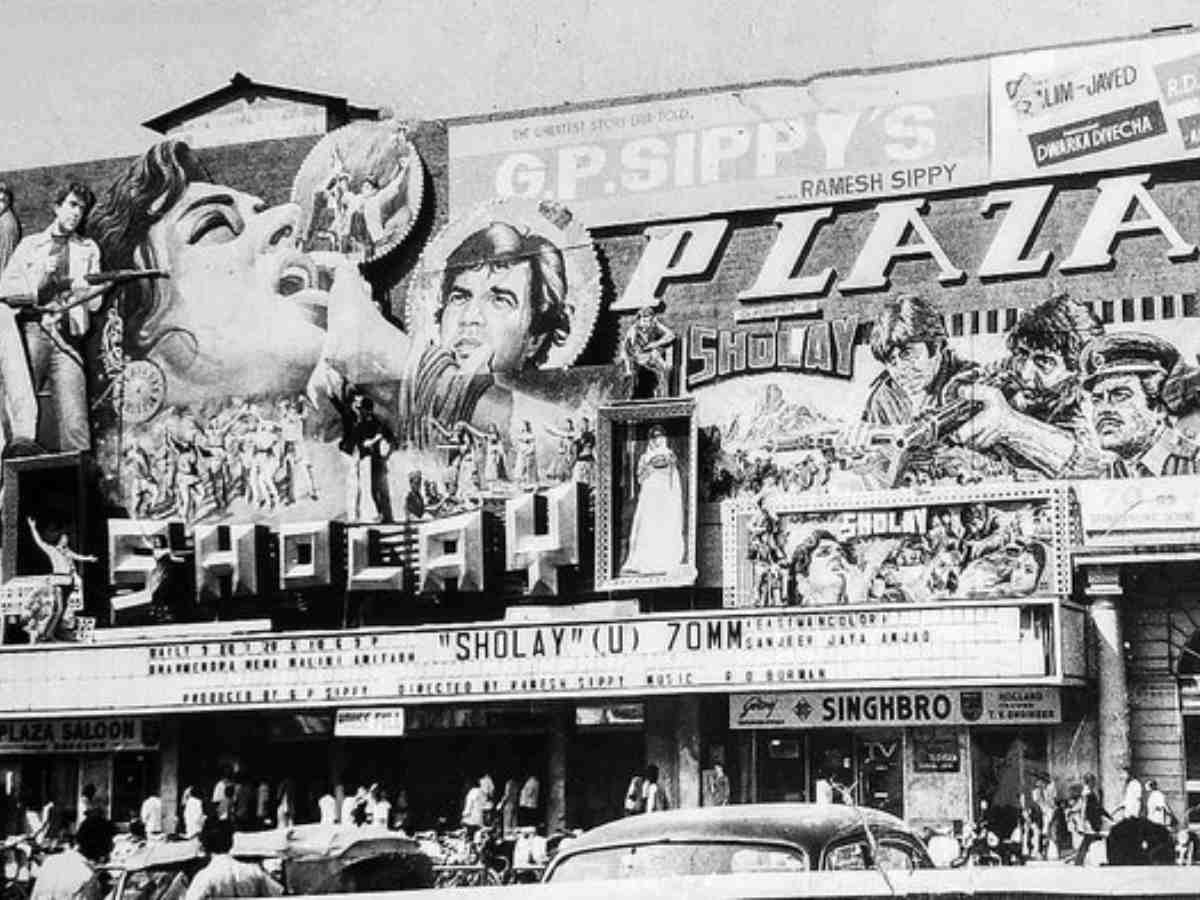Delhi: The distance between Plaza cinema in Connaught Place and the now-defunct Imperial in Paharganj was, at most, two to three kilometres. In 1975, exactly fifty years ago, Sholay and Jai Santoshi Maa were released in these theatres, respectively. Both films went on to achieve unprecedented success.
While anticipation for both films was high, their eventual release scripted a new chapter in the history of Indian cinema.
Older Delhiites recall how, around two weeks before Sholay’s release, large posters had appeared across South Extension, Ajmeri Gate, Minto Bridge, and Moti Nagar. These posters were far from uniform. Some featured Amitabh Bachchan and Dharmendra wielding guns, flanked by Amjad Khan as Gabbar Singh. Others included the entire principal cast, with SHOLAY emblazoned in bold letters. People eagerly scanned these posters from left to right, trying to guess the storyline. The capital was abuzz with speculation about the film even before its release.
“It was the era of political upheaval in the country. There was an atmosphere of fear, with many opposition leaders jailed. In such circumstances, the arrival of GP Sippy’s masterpiece, Sholay, certainly eased the tension,” recounts film enthusiast Sandeep Wahal, who watched the film more than a dozen times.
At the time, Delhi had not yet expanded to include areas like Mayur Vihar, Vasant Kunj, Dwarka, Rohini or the NCR. Before Sholay’s release at Plaza and Amba cinema in Shakti Nagar, long queues for tickets had already begun forming. At Plaza, the police had to keep a watchful eye on the crowd. This writer, then a schoolboy, recalls witnessing a lathi charge on the crowd that had gathered to buy tickets. Plaza drew a larger audience because it screened a 70mm print of Sholay, unlike Amba which used a smaller format.
As soon as it was released, Sholay’s magic swept across Delhi. Dialogues like “Kitne aadmi the?”, “Basanti, in kutton ke saamne mat naachna!”, “Yahan se pachaas-pachaas kos door gaon mein jab bachcha raat ko rota hai, toh maa kehti hai, ‘bete so jaa, so jaa, nahin toh Gabbar Singh aa jaayega’,” “Itna sannata kyun hai bhai?”, “Sardar, maine aapka namak khaya hai”, “Hum Angrezon ke zamaane ke jailer hain”, and “Jail mein chakki peesing and peesing” became part of Delhi’s everyday lexicon.
Also read: ‘Black Warrant’, ‘Maamla Legal Hai’ and two more shows renewed by Netflix
“The crowds eager to see Sholay at Plaza never dwindled, while at Amba, they only grew. Since Amba is adjacent to Delhi University’s main campus, it primarily attracted the DU community and residents of North Delhi,” recalls noted author Dr Aruna Mukim. Mukim, who lived in Model Town as a young girl, later moved to Civil Lines after marriage.
After its run at Plaza and Amba, Sholay was released at Novelty cinema in Mori Gate in November. At all three theatres, the film celebrated both its silver and golden jubilees.
It is said that even women from Delhi’s infamous GB Road would attend the 12 o’clock show of Sholay at Novelty, a theatre which opened in 1935. Ziya Us Salam, a writer known for chronicling Delhi’s film scene, notes that Sohrab Modi’s Minerva cinema did not screen Sholay despite considerable efforts, as the distributors ultimately chose not to release it there.
Since Sholay was not released in any cinema in trans-Yamuna or South Delhi, film enthusiasts from these areas had to travel long distances to watch it. Tax consultant Aslam Zaki, a resident of Vivek Vihar, recalls, “We East Delhi folks usually went to Plaza to see Sholay. It was a long haul to reach Connaught Place from East Delhi.
It is said that Sholay’s producer, GP Sippy, later built a magnificent bungalow in Mayfair Gardens, a Sindhi colony in South Delhi. However, the house largely remained unoccupied.
Faith, fervour, and a new goddess
The other major hit of 1975, Jai Santoshi Maa, had a profound cultural and religious impact, especially in Delhi and across North India. Not only did the film promote devotional fervour, it also brought about tangible social change.
Renowned film writer Dr Ravindra Kumar observes that the film established Santoshi Mata as a popular goddess—despite her not being mentioned in any scriptures. Among Delhi’s lower and middle classes, especially women, devotion to Santoshi Maa took root. Many began observing fasts on Fridays. In some cinemas, audiences would remove their footwear, offer flowers and coins during the screening, and treat the halls like temples. Small shrines dedicated to Santoshi Maa began appearing across the city.
Released at Imperial and Palace
Jai Santoshi Maa was released at Imperial in Paharganj and at Palace on Roshanara Road. Film lovers from North Delhi recall how audiences flocked to these theatres. Other devotional hits such as Dara Singh’s Bhakti Mein Shakti and Nanak Naam Jahaz Hai also did well at Palace.
A large Punjabi population had settled around Palace after Partition in 1947, and they gravitated towards films that reflected their cultural heritage.

Empowering women through faith
“I had watched Jai Santoshi Maa at Imperial. The film’s story, centred on the devotion and struggles of an ordinary housewife, emotionally connected with women in Delhi and across India,” says Dr Ravindra Kumar.
Film writer Harish Chandra recalls how people from both rural and urban Delhi would arrive at cinemas in groups. “The film fostered a sense of community by bringing different classes together. The distribution of prasad and sale of vrat kathabooklets outside cinemas turned it into a social festival,” he adds.
Images, idols, and booklets devoted to Santoshi Maa became a common sight outside theatres, boosting the income of local vendors.
A roaring success
Made on a modest budget of Rs 25–30 lakh, Jai Santoshi Maa earned Rs 5–10 crore—a profit of around 2000% at the time. Its simplicity and relatability made it immensely popular.
The film’s devotional songs by Usha Mangeshkar and Mahendra Kapoor, with lyrics by Kavi Pradeep—such as Main toh aarti utaroon re and Jai Jai Santoshi Mata—became household tunes. These are still sung during religious functions today.
Also Read: ‘I enjoy doing comedy roles:’ Rajkummar Rao on Bhool Chuk Maaf
Fifty years later
As film buffs commemorate the golden jubilee of Sholay and Jai Santoshi Maa, the theatres that screened them are no longer what they once were. Imperial and Palace have long shut down, their crumbling facades evoking a flood of memories from an era when cinema truly brought people together.
Thankfully, Plaza still stands—though it is no longer a single-screen theatre.





